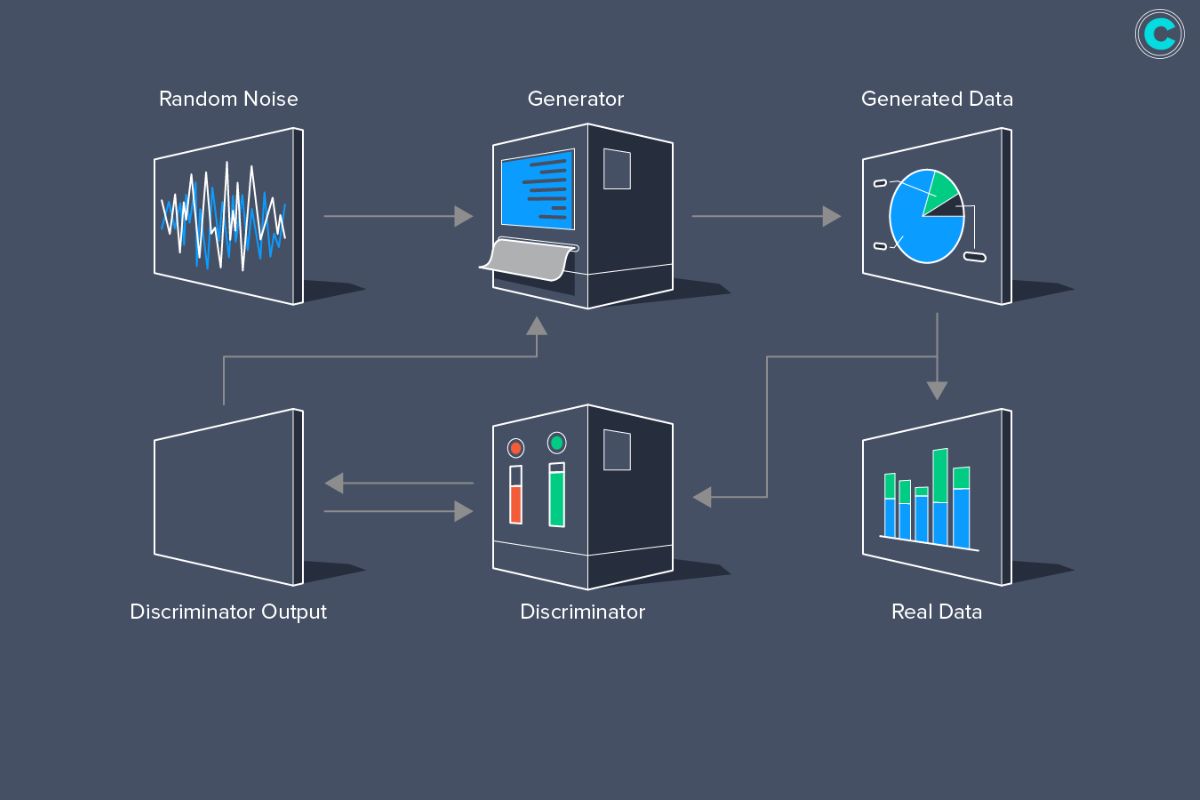In the world of artificial intelligence, there’s this super cool thing called Generative Adversarial Networks (GANs). They’re like the superheroes of machine learning because they can learn and create in mind-blowing ways. GANs have this amazing power to generate new data that looks just like the real deal, which has got everyone – researchers, businesses, and fans – super excited. In this article, we’re going to take a deep dive into the world of Generative Adversarial Networks. We’ll explore how they work, check out all the different things they can do, and even peek into what the future might hold for them.
What is a Generative Adversarial Network (GAN)?
A Generative Adversarial Network, or GAN, is a type of artificial intelligence model comprising two neural networks, the generator, and the discriminator, engaged in a competitive game. The generator aims to produce synthetic data resembling authentic samples, while the discriminator endeavors to differentiate between real and fake data. Through this adversarial process, GANs learn to generate increasingly realistic outputs.
How do GANs Work?
Generative Adversarial Networks (GANs) are a type of machine learning model that consists of two neural networks: the generator and the discriminator. GANs use an adversarial training process to generate data that resembles the training data. Let’s dive deeper into how GANs work:
1. Generator

The generator network takes random noise as input and attempts to produce data that mimics the distribution of the training data. It starts with a random data distribution and tries to replicate a particular type of distribution. The generator’s goal is to generate samples that are similar to the real data in the training set.
2. Discriminator
The discriminator network evaluates the generated data, discerning whether it is real or fake. It acts as a classifier, trying to distinguish between real data instances and data created by the generator. The discriminator’s training data comes from two sources: real data instances and fake data instances created by the generator. During training, the discriminator learns to become more adept at distinguishing real from fake data.
3. Adversarial Training
During training, the generator aims to fool the discriminator by generating data indistinguishable from authentic samples. Conversely, the discriminator learns to become more skilled at flagging synthetic samples. This adversarial process leads to the generator creating increasingly better data over time. The generator loss is calculated based on the discriminator’s classification, rewarding the generator if it successfully fools the discriminator and penalizing it otherwise.
The training process involves an adversarial game between the generator and the discriminator. The generator tries to produce samples that fool the discriminator, while the discriminator tries to improve its ability to distinguish between real and generated data. This competitive interaction drives both networks toward advancement .
Improving GAN Results
To enhance GAN results, several techniques can be employed:
- Adjusting hyperparameters: Fine-tuning the parameters of the GAN model can have a significant impact on its performance.
- Increasing model complexity: Increasing the complexity of the generator and discriminator networks can lead to better results.
- Implementing regularization techniques: Regularization techniques, such as adding noise to the input or using dropout, can help prevent overfitting and improve the generalization of the GAN model.
- Experimenting with advanced GAN variants: Exploring advanced GAN variants like Wasserstein GAN (WGAN) or Deep Convolutional GAN (DCGAN) can yield improved results in specific domains.
Applications of Generative Adversarial Networks

- Image Generation: GANs excel at generating photorealistic images, finding applications in art generation, photo editing, and content creation.
- Data Augmentation: GANs can augment training data by generating synthetic samples, enhancing the robustness and diversity of machine learning models.
- Anomaly Detection: GANs can identify anomalies in data distributions, aiding in fraud detection, cybersecurity, and medical diagnosis.
- Style Transfer: GANs facilitate the transfer of style and characteristics between images, enabling artistic rendering and creative expression.
- Drug Discovery: GANs contribute to the generation of molecular structures and drug compounds, accelerating drug discovery processes.
Challenges and Limitations
While Generative Adversarial Networks offer immense potential, they also pose several challenges and limitations:
- Mode Collapse: GANs may suffer from mode collapse, where the generator produces limited varieties of outputs, failing to capture the entire data distribution.
- Training Instability: GAN training can be notoriously unstable, requiring careful tuning of hyperparameters and regularization techniques.
- Evaluation Metrics: Assessing the performance of GANs remains a challenging task, as conventional evaluation metrics may not capture the true quality of generated samples.
- Ethical Concerns: The use of GANs raises ethical considerations regarding the generation of synthetic media, including deepfakes and misinformation.

Future Directions and Innovations
Despite the challenges, ongoing research in Generative Adversarial Networks promises exciting developments and innovations:
- Improved Architectures: Researchers are continually devising novel GAN architectures, such as conditional GANs and Wasserstein GANs, to enhance performance and stability.
- Unsupervised Learning: GANs hold the potential to drive advancements in unsupervised learning, enabling machines to learn from unlabeled data without explicit supervision.
- Multi-modal Generation: Emerging GAN variants aim to generate multi-modal outputs, including text, audio, and video, expanding the scope of creative applications.
- Interdisciplinary Applications: GANs are increasingly being applied across diverse domains, including healthcare, robotics, and natural language processing, fostering interdisciplinary collaborations and innovations.
FAQs
1. How are GANs different from other generative models?
GANs differ from traditional generative models by employing a competitive framework between two neural networks, the generator and discriminator, to generate realistic data.
2. What are some real-world applications of GANs?
GANs find applications in image generation, data augmentation, anomaly detection, style transfer, and drug discovery, among others.
3. What are the main challenges in training GANs?
Challenges in training GANs include mode collapse, training instability, evaluation metrics, and ethical concerns regarding synthetic media generation.
4. How do GANs contribute to unsupervised learning?
GANs enable unsupervised learning by learning to generate data distributions without the need for labeled training data, thus facilitating learning from unlabeled data.
5. What are some recent innovations in the field of GANs?
Recent innovations in GANs include improved architectures, unsupervised learning capabilities, multi-modal generation, and interdisciplinary applications across various domains.
Conclusion
In conclusion, Generative Adversarial Networks represent a transformative paradigm in artificial intelligence, empowering machines to generate creative and realistic outputs. From image generation to drug discovery, GANs are poised to reshape industries and drive innovation across diverse domains. As research progresses and technologies evolve, the potential of GANs to revolutionize AI and society at large is indeed promising.






